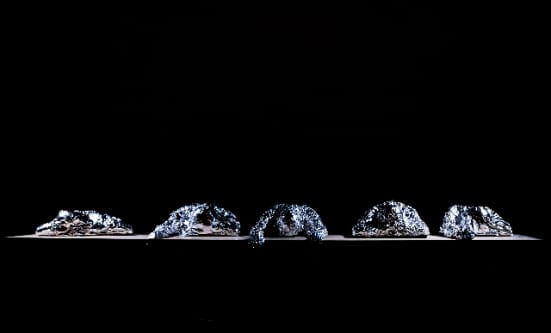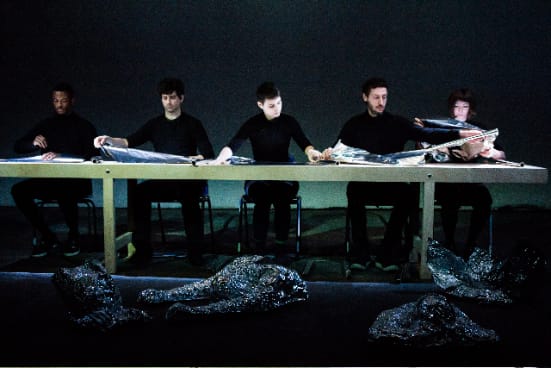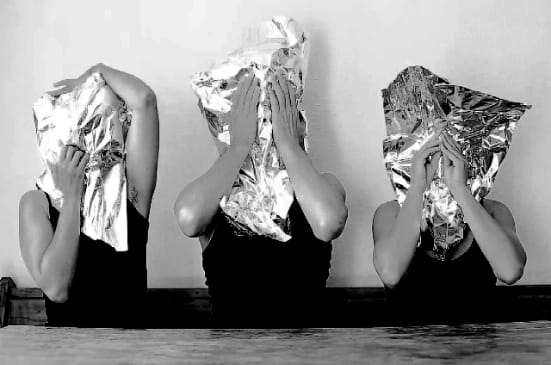25th March 2014 — 29th March 2014
To innocence
The word innocence is no longer a noun but a verb, according to Anton Mirto’s new work – earning innocence. Being without sin only applies (in the social context) when the value of the self goes before the spirit to build its kingdom on earth. Bridging the ordinariness with man’s inner spheres in a performance is the revealing talent of Mirto, who as well as being co-artistic director of A2company created a solo work presented at The Yard Theatre at the end of March 2014.
We are living in the era of installation performances if we think of the visual domination of images and also consider the fact that the live presentation of art is set in a position as if it were a painting, a sculpture or a photograph. The visual is more important than ever, and so the performing arts enter the space of galleries and museums. But there is something else behind this expansion: memory.
In the opening scene of earning innocence the five, half-cast bodies of the performers are made of aluminium foil. It recalls the human sculptures of Pompeii, but points to a futuristic time when it may not be nature that entombs the dead. This motionless landscape of a gleaming material, even after the diverse figures come into sight, keeps its form. The five performers sitting behind a minimalist wooden table roll out meters of foil, rip and apply it to their own face or onto the face of the other. Masks are ritualistically made and pushed forward to fall in front of their legs. The moulded structure speaks of its sculptor, and when the spectator identifies these two with each other, a recognition of a person’s individuality occurs. But is this perception true? On which of our senses should we truly rely? In the state of being masked the performers are not able to see, smell or hear the outer world, but smell their own breath, taste their own flavour, feel the touch of the other, see the images of the mind and are within the space of thoughts. While they experience their inner being, we watch their images in beautiful lighting accentuating their shining faces in pitch black. On each occasion when there is a pause in the choreography, a framed photograph, sculptural work or painting is perceived. At these moments time is given to the audience to memorise what is seen, but these segments of the present pass by and through us so quickly that we scarcely notice them. (Despite our intention.)
earning innocence is an installation performance, if we consider the visual solutions of the show, but there is also a struggle against the power of images within. By separating images from the body (even the image of the body is transported to tin foil) a different sphere of the existence is sensed, that is not visible to the naked eye, but present as core of the performance.
When the painters, Zeuxis and Parrhasius were competing for the truest representation of reality, it was not only for the sake of hubris, but to eternalise life. We don’t know where images go, but they definitely die. In today’s rolling river of events, time is washed out to the shores, while we are taught that the best we can do to hold on to our history is to preserve, to build archives. The memory making machine – that Terry Gilliam might have already made – is in operation, whilst the possibility to innocence is in front of us. Earning innocence equals earning remembering, in which the answer to ‘what would remain if all your worldly memory is gone?’ might be a single you.
Darinka Pilári
Interview with Anton Mirto on the occasion of her work earning innocence
A. Mirto: earning innocence, an evolving installation performance, explores spheres of our inner and social self and a temporal sense of presence. Whilst all that is seen are five people sitting behind a table continually making masks from aluminum foil, the imagination is sublimely carried to experience an elsewhere, erasing time and place.
AM: Where did the inspiration for earning innocence come from?
A. Mirto: From wanting to look at / remember myself more closely! But the visual inspiration is rooted in the time of the financial crisis, when I had ideas about encasing a breathing body in papier maché using shopping catalogue pages to explore the consumerism-trap, the being caught by the desire to acquire. I have a continuous interest in what type of practices our culture and society offer the individual in order to create identity. We can experiment with multiple versions of ourselves in the hope of finding a true one but can become stuck, holding a position, a set of behavioral pattern or point of view despite the surrounding context changing.
So the idea to entrap the human form in diverse configurations has been with me for some time, yet I was searching for a more immediate way to create a sculptural shell for the face and other body parts, taking further inspiration from the figures preserved in lava at Pompeii. It wasn't until roasting a chicken that I discovered the pliability of silver foil. Instead of putting the foil on the bird, it was instinctively drawn up to my face and by applying pressure I began to delineate my contours ... (is looking for who you are being who you are?)
AM: Could you tell me a little about the development and rehearsal process of earning innocence?
A. Mirto: In practice I started with three exploratory workshops with about thirty people across backgrounds (for example a scenographer, an architect, a psychologist, a dancer, a friend). Through tasks given, improvisation, foil and movement we worked around ideas about hiding, finding, remembering and representing multiple versions of the self. In the rehearsal process and resultant work, the performers sculpt blindly as they continually and ritualistically draw up the foil to their face to embody the next mask and as the foil scrunch-sound is loud, nor can they hear, which required a different approach to directing and performing as the inner eye deconstructs the position of the 'I' ... Hours of contact improvisation (eyes closed, no cheating) to sense, smell, feel their way around each other, the material, furniture and space ... working with sound cues and some inpidual whispering in their ears.
AM: earning innocence was your first solo project. You have worked as half of A2 Company with Alit Kreiz since 1999. What have been some of the highlights of your collaboration to date?
A. Mirto: A three month residency at Parc de la Vilette, Paris exploring the interrelationship between living and dying: the changes of heart made (if any) on the verge of death and how this can effect our choices for living now.
Our research included leading video workshops with five terminally ill patients in palliative care hospices. Two of whom died in the course of us being there. Perhaps this doesn't sound much like a highlight, but the lessons learnt continue to reward all those involved. It was a process of letting go ... and of being fearless. Something I have perhaps forgotten since ...
An installation performance called the future of death where forty local people gradually bury each other with earth. Since its first presentation at the ICA, London in 2005, this work has been created in Lancaster, Ljubliana, Vienna, Jerusalem, Dortmund. Each installment is unique and reflective of the time, place and new diverse people involved.
And tights, (Royal Opera House, London and the Center of Contemporary Arts, Barcelona) being strung up, as a performer this time with Alit, with 9m of 70 dernier tights from lighting scaff, extending and reflecting relationships between points, lines, curves and each other - merging body, geometrics, architecture and meaning.
AM: What's next?
A. Mirto: As a solo artist - Scaffolding an appropriation of the tights work above, but within the public realm from a tower block with up to forty people involved. A further itineration of earning innocence with more people involved mass producing ... In collaboration with Alit (A2Company) a residency in the lands of Tuscany this year ... we are thinking of making a short film ...
Ali MacGilp

Anton Mirto earning innocence 2014
The Yard, Hackney Wick
Photograph: Adam Petto

Anton Mirto earning innocence 2014
The Yard, Hackney Wick
Photograph: Adam Petto

Anton Mirto earning innocence 2014
The Yard, Hackney Wick
Photograph: Adam Petto

Anton Mirto earning innocence 2014
The Yard, Hackney Wick
Photograph: Adam Petto

Anton Mirto earning innocence 2014
The Yard, Hackney Wick
Photograph: Darinka Pilári

Anton Mirto and it went everywhere / part II
At Richard Wentworth's Black Maria, Granary Building, London, 2013
Photograph: Chus Moreno

Anton Mirto and it went everywhere / part II
At Richard Wentworth's Black Maria, Granary Building, London, 2013
Photograph: Chus Moreno